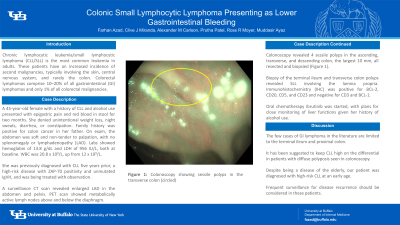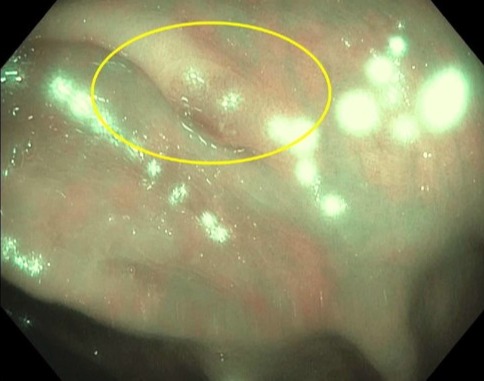Monday Poster Session
Category: Colon
P1725 - Colonic Small Lymphocytic Lymphoma Presenting as Lower Gastrointestinal Bleeding
Monday, October 23, 2023
10:30 AM - 4:15 PM PT
Location: Exhibit Hall

Has Audio

Farhan Azad, DO
University at Buffalo
Buffalo, New York
Presenting Author(s)
Farhan Azad, DO, Clive J. Miranda, DO, MS, Alexander M. Carlson, DO, Prutha Patel, DO, Ross R. Moyer, DO, Muddasir Ayaz, MD
University at Buffalo, Buffalo, NY
Introduction: Chronic lymphocytic leukemia/small lymphocytic lymphoma (CLL/SLL) is the most common leukemia in adults. These patients have an increased incidence of second malignancies, typically involving the skin, central nervous system, and rarely the colon. Colorectal lymphomas comprise 10–20% of all gastrointestinal (GI) lymphomas and only 1% of all colorectal malignancies.
Case Description/Methods: A 45-year-old female with a history of CLL presented with worsening intermittent epigastric pain and red blood in stool for two months. She was diagnosed with CLL five years prior, high-risk disease with ZAP-70 positivity and unmutated IgVH, and was being treated with observation. She denied unintentional weight loss, night sweats, chest pain, shortness of breath, diarrhea, or constipation. The family history was positive for colon cancer in father, and social history was significant for daily tobacco and alcohol use. On exam, the abdomen was soft and non-tender to palpation, with no splenomegaly or lymphadenopathy (LAD) noted. Laboratory values revealed hemoglobin of 13.8 g/dL and LDH of 956 IU/L, both near her baseline. WBC was 20.8 x 109/L, up from 12 x 109/L previously. A surveillance CT scan revealed enlarged LAD in the abdomen and pelvis concerning for worsening disease. PET scan revealed multiple metabolically active lymph node chains above and below the diaphragm. Colonoscopy revealed 4 sessile polyps in the ascending, transverse, and descending colon, the largest 10 mm, all resected and biopsied (Figure 1). Biopsy of the terminal ileum and transverse colon polyps revealed small lymphocytic lymphoma involving the lamina propria. In addition, a nonbleeding 5 mm ulcer was found in the rectum, with biopsy negative for dysplasia or malignancy. Immunohistochemistry (IHC) was positive for BCL-2, CD20, CD5, and CD23 and negative for CD3 and BCL-1. Oral chemotherapy ibrutinib was started, with plans for close monitoring of liver functions given her history of alcohol use.
Discussion: The few cases of GI lymphoma in the literature are limited to the terminal ileum and proximal colon. Some also suggest keeping CLL high on the differential in patients with diffuse polyposis seen in colonoscopy. Given the disease progression, chemotherapy was promptly initiated. Despite being a disease of the elderly, our patient was diagnosed with high-risk CLL at an early age. Frequent monitoring for colorectal cancer and surveillance for disease recurrence should be considered for these patients.

Disclosures:
Farhan Azad, DO, Clive J. Miranda, DO, MS, Alexander M. Carlson, DO, Prutha Patel, DO, Ross R. Moyer, DO, Muddasir Ayaz, MD. P1725 - Colonic Small Lymphocytic Lymphoma Presenting as Lower Gastrointestinal Bleeding, ACG 2023 Annual Scientific Meeting Abstracts. Vancouver, BC, Canada: American College of Gastroenterology.
University at Buffalo, Buffalo, NY
Introduction: Chronic lymphocytic leukemia/small lymphocytic lymphoma (CLL/SLL) is the most common leukemia in adults. These patients have an increased incidence of second malignancies, typically involving the skin, central nervous system, and rarely the colon. Colorectal lymphomas comprise 10–20% of all gastrointestinal (GI) lymphomas and only 1% of all colorectal malignancies.
Case Description/Methods: A 45-year-old female with a history of CLL presented with worsening intermittent epigastric pain and red blood in stool for two months. She was diagnosed with CLL five years prior, high-risk disease with ZAP-70 positivity and unmutated IgVH, and was being treated with observation. She denied unintentional weight loss, night sweats, chest pain, shortness of breath, diarrhea, or constipation. The family history was positive for colon cancer in father, and social history was significant for daily tobacco and alcohol use. On exam, the abdomen was soft and non-tender to palpation, with no splenomegaly or lymphadenopathy (LAD) noted. Laboratory values revealed hemoglobin of 13.8 g/dL and LDH of 956 IU/L, both near her baseline. WBC was 20.8 x 109/L, up from 12 x 109/L previously. A surveillance CT scan revealed enlarged LAD in the abdomen and pelvis concerning for worsening disease. PET scan revealed multiple metabolically active lymph node chains above and below the diaphragm. Colonoscopy revealed 4 sessile polyps in the ascending, transverse, and descending colon, the largest 10 mm, all resected and biopsied (Figure 1). Biopsy of the terminal ileum and transverse colon polyps revealed small lymphocytic lymphoma involving the lamina propria. In addition, a nonbleeding 5 mm ulcer was found in the rectum, with biopsy negative for dysplasia or malignancy. Immunohistochemistry (IHC) was positive for BCL-2, CD20, CD5, and CD23 and negative for CD3 and BCL-1. Oral chemotherapy ibrutinib was started, with plans for close monitoring of liver functions given her history of alcohol use.
Discussion: The few cases of GI lymphoma in the literature are limited to the terminal ileum and proximal colon. Some also suggest keeping CLL high on the differential in patients with diffuse polyposis seen in colonoscopy. Given the disease progression, chemotherapy was promptly initiated. Despite being a disease of the elderly, our patient was diagnosed with high-risk CLL at an early age. Frequent monitoring for colorectal cancer and surveillance for disease recurrence should be considered for these patients.

Figure: Figure 1: Colonoscopy showing sessile polyps in the transverse colon (circled)
Disclosures:
Farhan Azad indicated no relevant financial relationships.
Clive Miranda indicated no relevant financial relationships.
Alexander Carlson indicated no relevant financial relationships.
Prutha Patel indicated no relevant financial relationships.
Ross Moyer indicated no relevant financial relationships.
Muddasir Ayaz indicated no relevant financial relationships.
Farhan Azad, DO, Clive J. Miranda, DO, MS, Alexander M. Carlson, DO, Prutha Patel, DO, Ross R. Moyer, DO, Muddasir Ayaz, MD. P1725 - Colonic Small Lymphocytic Lymphoma Presenting as Lower Gastrointestinal Bleeding, ACG 2023 Annual Scientific Meeting Abstracts. Vancouver, BC, Canada: American College of Gastroenterology.
